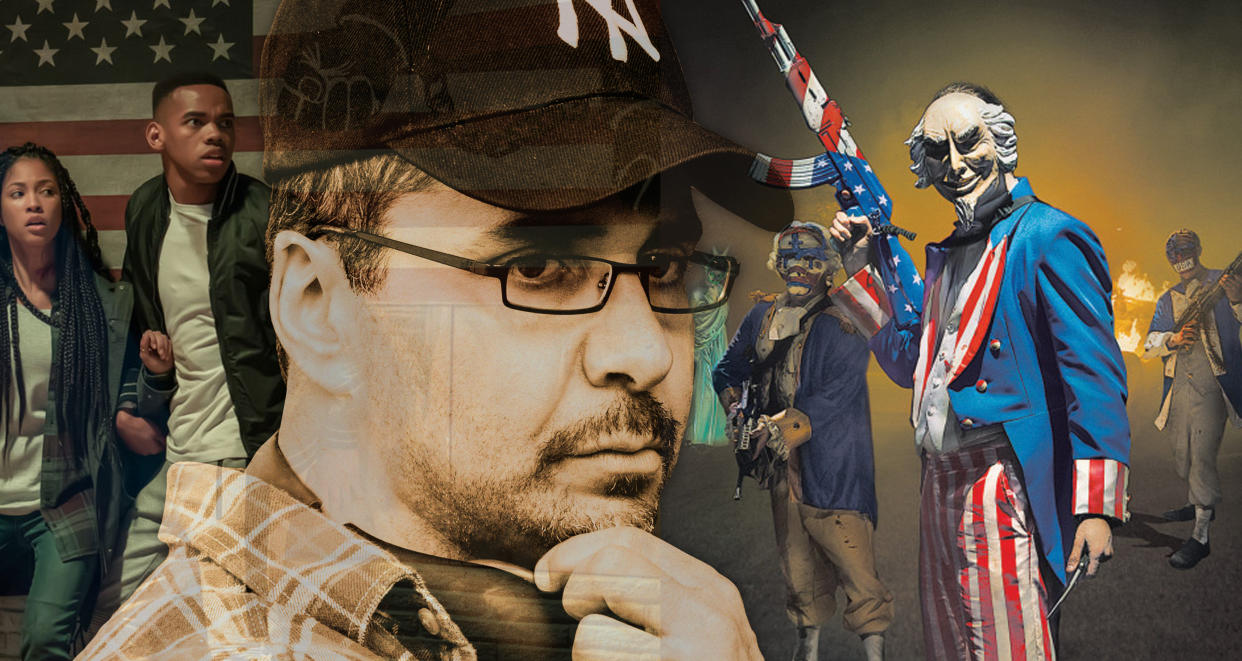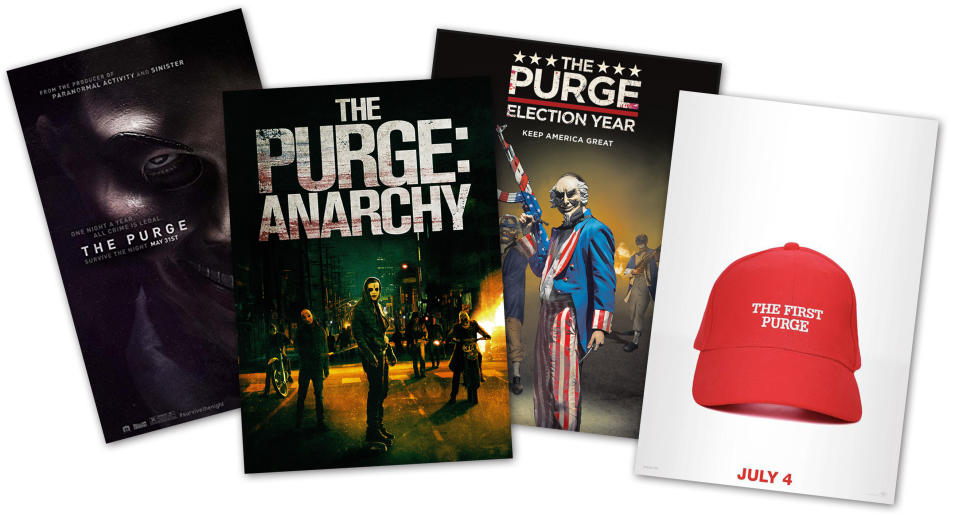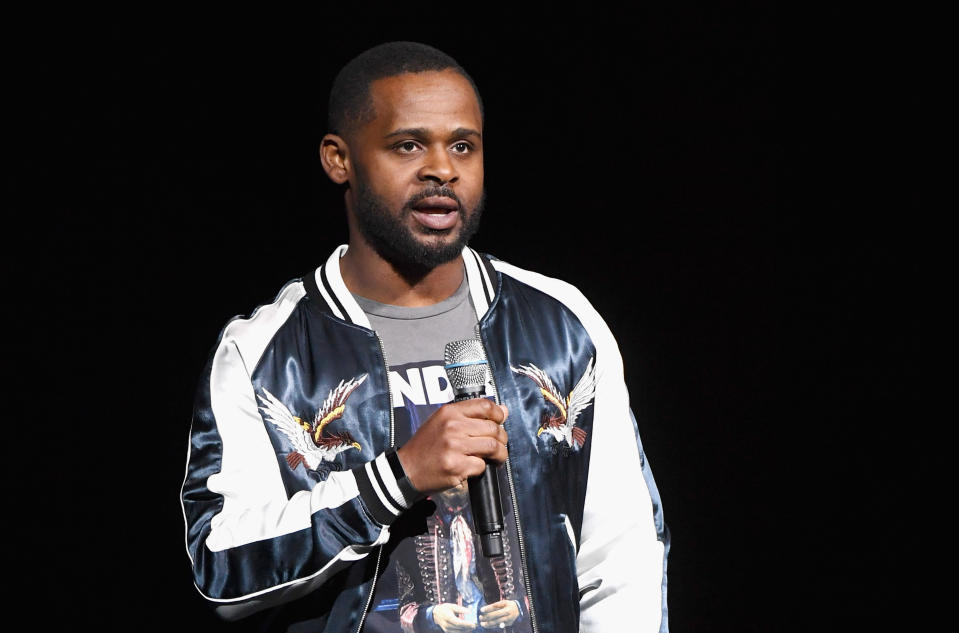Coming to a country near you: The nightmare world of James DeMonaco’s ‘The Purge’

Which piece of pop culture is most representative of Donald Trump’s America? Eighteen months into his presidency, there’s been plenty of media created as a response to the country’s current moment. There’s “Homeland,” where the Russians are the villain, and the now-canceled “Designated Survivor,” in which the president was removed from office via the 25th Amendment. There is the theocratic, misogynistic hellscape of “The Handmaid’s Tale,” the popular-but-canceled-but-then-revived “Roseanne” remake and celebrated views from a black perspective (Kendrick Lamar’s Pulitzer-winning “Damn,” Donald Glover’s Emmy-winning “Atlanta”). But it’s possible that the pop culture that best represents 2018 America is a dystopian horror movie franchise with an origin well predating Trump: “The Purge.”
The concept of the “Purge” franchise, which began in 2013, and whose fourth installment is out this month, to be followed by a television series later this year, is simple: For one night a year in the United States, all crime is legal — explicitly and pointedly including murder. The result is a 12-hour free-for-all that gives filmmakers an open canvas to explore the darkest corners of their imagination, along with familiar horror and action tropes. The films are hyperviolent and vary in overall quality, but they are dense with messaging, conveyed at times with a heavy hand. (Although perhaps in a time when the first lady dresses for an official visit in a jacket bearing a provocative all-caps message, we must question how subtext even functions.)
The premise of “The Purge” is this: An ultraconservative political party called the New Founding Fathers of America takes power in the United States and decrees that to defuse the culture wars, on one night a year, citizens will be free to settle scores and unleash their anger without consequences. It becomes a religious experience for some, with Purge ceremonies, wrapping America’s love of guns and violence into its affinity for patriotism and ritual, celebrated by news media as it takes the mantra “If it bleeds it leads” to unprecedented extremes. Its effects on the nation’s psychology, its unemployment rate and its morale are all praised by the elites in power.
In this, the films have echoes of Shirley Jackson’s “The Lottery,” a short story in which a town randomly selects a citizen to be stoned to death as a sacrifice. (Jackson said some readers wrote her asking where the stoning festivals were held and whether they could go watch.) They also follow the Greek tradition of the pharmakos, where one citizen was driven out of town or killed in an attempt to rid the community of ill luck or a specific plague or disaster.

But the revealed agenda of “The Purge” is to eliminate low-income Americans considered by the ruling party — and the generally wealthy pro-Purge parts of society — as burdens and parasites. The rich are able to afford protection, via armed guards or elaborate security systems, with powerful government officials completely exempt. This leaves the poor, often minority populations to fend for themselves against state-sanctioned murder. In the first movie, we hear a caller on a talk radio show say that he saw people being dragged out of “tenements” and murdered. In the second, organized strike teams conduct raids in housing projects, killing residents or dragging them off to be hunted for sport, à la “The Most Dangerous Game.” Few films are as consistently class- and race-conscious as “The Purge” series, or as violent.
“How do you deal with class and not race?” said James DeMonaco, who wrote all four movies and directed the first three, in an interview with Yahoo News. “There’s a great racial component in class warfare in our country. I felt it was coupled together.”
The first film in the series introduces the concept on a small scale, built around a classic, claustrophobic home-invasion plot. But larger themes are at play: The house being invaded is owned by a salesman played by Ethan Hawke, who became wealthy selling home-security devices in a market created by “The Purge.” The villains are the salesman’s comfortable suburban neighbors and a group of rich twentysomethings hunting a black homeless man. The world expands in the second film, “The Purge: Anarchy,” depicting the horror on the streets during Purge night, following a vigilante looking for justice for his son and some innocent bystanders caught in the wrong place at the wrong time. Here we see the first set of anti-Purge activists, as well as the government shock troops sent to poorer areas to carry out extermination, and the threat specific to women on a night where rape is legal.
The subtext becomes bold, underlined and highlighted in the third film in the series, 2016’s “Purge: Election Year.” Anti-Purge sentiment has reached such a fervor that a senator running on a campaign to abolish the annual tradition scares the ruling party into ordering her assassination, with the protections on government officials lifted. The media gives more weight to the charge that the Purge is enriching corporations. (One subplot revolves around an insurance company increasing premiums on a black deli owner the day before the Purge.) The climactic scene is in a church where Purge killing ceremonies are happening, presided over by a minister who is also the New Founding Fathers’ presidential candidate.
The newest film, “The First Purge,” is a prequel that explains the Purge’s origins, with Staten Island as the test case. DeMonaco said he wanted to stress how evil ideas could be sold if the media and public are not critical enough, and in the film, cable news obliges, airing highlights as if it’s the NFL RedZone channel of mass murder. It also emphasizes that the psychology behind the concept was specious from the start, and that the agenda was always to eliminate the lower class.
Is America that close to state-sanctioned killing? Some say it’s already happening in some minority communities. Dozens of unarmed black males have been killed by police over the last three years. The inadequate federal response to Hurricane Maria led directly or indirectly to the deaths of as many as 4,000 civilians, by some estimates — all of them Puerto Rican. And the government perpetrates other forms of dehumanization, especially of immigrants. The president discusses immigration using a word — “infest” — that suggests a comparison with vermin. Parents crossing the border seeking asylum have their children taken from them. Flint, Mich., still does not have clean water, and black Americans have the same life expectancy as white Americans did in the 1980s.
The Purge also depicts an America hostile to the poor. A June United Nations report stated that the United States had become “a champion of inequality” and that the Republican-sponsored tax cuts would make the situation worse. Proposed legislation to repeal the Affordable Care Act and cut Medicaid (the health care program for low-income and disabled Americans) could leave millions without health care. (While the repeal failed last year, some Republicans are considering another approach, excluding the act’s guarantee of coverage of preexisting conditions.) Many poor people are thrown in jail due to their inability to pay fines of a few hundred dollars. It is a contempt for certain segments of society that might not be a night of murder but is a gradual destruction of life, fueling “deaths of despair” in some areas.
Just as the “Purge” franchise predates Trump, so do America’s problems. Obama was criticized for his administration’s inconsistently harsh immigration enforcement, and on the economic front, critics have said his Treasury secretary was more concerned with protecting banks than homeowners after the market crash of 2008. George W. Bush’s Iraq War and its lax response to Hurricane Katrina led to the deaths of hundreds of thousands. Go further back in history and things get darker: slavery, lynchings, internment camps, genocides of Native Americans — more literal purges.

Per DeMonaco, the treatment of the poor black community of New Orleans after Katrina served as part of his inspiration for the original film. He found someone to connect with this vision in Gerard McMurray, a New Orleans native, who directed “The First Purge.”
“If you talk to Gerard, specifically, who lived through [Katrina], it was never good in certain demographics of this country,” said DeMonaco. “It still wasn’t perfect under the Obama administration or the Clinton administration. We live in a predatory economic system that sometimes takes advantage of the poor. There’s no way around that, and that system survives through Democratic administrations. How? Why? I don’t know, they can’t stop the rush of it or because it’s so successful for the rich. It’s so easy to demonize Trump — I do it all the time — but it’s been imperfect for many, many years, well before he came in.”
While the films were inspired by real events, they also manage to presage them. The group hired to carry out the senator’s assassination in the third film? Neo-Nazis, which DeMonaco called the “scariest people in the world.” The predominantly white ruling party aligning itself with Nazis occurred over a year before the white-supremacist march in Charlottesville, Va., where a young woman was killed. Today a candidate allied with white supremacists is running for the Senate in Virginia with the support of President Trump. (“I get no joy that some of this stuff is coming true,” said DeMonaco.) The “Purge” films are a funhouse mirror reflecting America, and also a potentially dark vision of its future.
But the protagonists of “The Purge” have evolved in a way that echoes reality, with activists and humanitarian volunteers fighting back against the purges. Some are as violent as the movie’s villains and vigilantes, while others employ nonviolence, sheltering potential victims. The hero of the third film, a female U.S. senator and presidential candidate named Charlie Roan, campaigns on a promise to end the sanctioned killings. Even in a world as violent as the cinematic universe of “The Purge,” empathy and mercy are rewarded, allowing a glimmer of hope that grows brighter as the series progresses.
With two and a half years left of Trump’s scheduled first term, there will almost certainly be an epic novel or cinematic masterpiece that perfectly captures the current Zeitgeist, to explain this era to future generations. But until then, surprisingly, the best representation of today’s America is a horror series whose initial offering was made on a $3 million budget and has a Rotten Tomatoes score of 38 percent.
_____
Read more from Yahoo News:
SCOTUS pick should be grilled about Mueller probe: Top Dem strategist
In some midterm races, addiction is a crisis that transcends party politics
The Democratic Socialists of America show their muscle in NY congressional upset
Democrats gear up for a fierce and probably losing fight against Trump’s court pick
With DACA phasing out, college graduates face an uncertain future
Photos: Multiple wildfires burn out of control in Northern California



